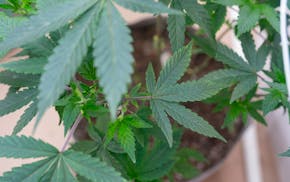So far this decade, Twin Cities' suburbs have grown faster than the urban core.
That's a marked shift from the 2010s, when much of the region's growth was concentrated in Minneapolis and St. Paul.
The new growth has been uneven, though, as different cities, and the neighborhoods within them, add housing at different rates, determined by constraints like zoning rules, local politics and land availability.
In recent years, a housing shortage has increased demand for a limited number of homes. And, in the past half-decade, a global pandemic disrupted the economy and changed how people live and work in ways that could take years to shake out.
Here are four Twin Cities communities that are among the fastest growing — for different reasons.
Lakeville housing bonanza
Lakeville stands out as a big suburb that grew faster than its big-suburb brethren.
The south metro suburb added more people than any city in the metro between 2020 and 2023, reaching 75,217 residents, according to population estimates from the Met Council. It surpassed Blaine and Maple Grove, becoming the metro's seventh-biggest city.
Mayor Luke Hellier pointed to a boom in housing of all types in the early part of the decade when interest rates were low.
"We haven't had a ton of multifamily [developments] over the years, and during the pandemic, when money was cheap, we were getting tons of proposals," he said. The city permitted nearly 1,200 multifamily units between 2020 and 2023, Met Council data show. It added even more single-family homes and also has seen an increase in townhomes.
Hellier said Lakeville benefits from its schools, natural amenities and location off Interstate 35. Plus, the pandemic changed the commuting calculus for Lakeville residents working from home or heading less often to downtown offices.
Restaurants are coming in, catering to the work-from-home crowd on lunch breaks.
"We've had interest from some commercial and retail that we hadn't had, and we've had a ton of investment in the health care, medical office space," Hellier said.
Unlike built-out inner ring suburbs, Lakeville still has space to grow. Met Council forecasters project Lakeville reaching an estimated 90,000 people in 2050.
Minneapolis parking turns into apartments
Three decades ago, Minneapolis' fastest-growing district, in the areas surrounding downtown known as Downtown East and Elliot Park, was "great plains of surface parking lots" where skyscrapers dropped off at the edge of town, according to a 1994 Star Tribune story.
Now, it's a bustling mixed-use area. Much of the parking has disappeared and areas to the east and southeast of those skyscrapers have turned into neighborhoods.
Between 2010 and 2020, Downtown East was the fastest-growing Minneapolis neighborhood, said Justin Hollis, a research scientist with Minnesota Compass, growing by more than 10%. At the same time, the North Loop grew by nearly 6%.
Data from Minnesota Compass show more than half of the housing units in Downtown East have been built since 2010.
"Housing units and the growth in population, they sort of grow together. And if you know anything about Downtown East over the past 10 years, there's been a lot of residential construction in those areas," Hollis said.
Since 2020, the population boom has moved south of U.S. Bank Stadium into Elliot Park, data from the Metropolitan Council show.
These areas are among several near the Green Line light rail that have seen population growth as a result of multifamily redevelopment, Met Council data show.
St. Anthony apartment boom
Inner-ring suburbs sprouted from farmland to shelter a booming population after World War II. Today, they are largely built out with little land for new development. To grow, they must add infill or redevelop.
St. Anthony, with nearly 8% growth between 2020 and 2023, sticks out among a group that saw modest, if any, growth in that time. The city permitted 628 multifamily units and added 721 residents between 2020 and 2023, according to Met Council data.
Mayor Wendy Webster said the increase illustrates the impact a few projects can have on a small city — St. Anthony is just two square miles.
A development on Stinson Boulevard that opened in 2022 added 42 units of workforce housing, with rents affordable to people making $20 an hour. Then came the Ruby, an apartment building built on a former Walmart site, adding 250 units in its first phase and expected to add another 250 in a second phase.
Redevelopment projects like these are reshaping inner-ring suburbs, said Todd Graham, Met Council principal forecaster, and are expected to continue to add population to these cities.
"There's a story there about developers looking at it opportunistically for redevelopment sites that were once commercial or office," he said. With less demand for those uses, cities and developers alike are looking toward mixed-use or high-density, he said, pointing to the area around Southdale Center in Edina.
St. Anthony is split between Ramsey and Hennepin counties. While the Hennepin County side is mostly single-family residential, said Webster, the Ramsey County side is more mixed-use and becoming more dense.
Dayton fields sprout houses
Diminutive Dayton, a city mostly on the fringes of the northwest metro, has seen bigger population growth by percentage than any other city in the Twin Cities metro. It grew 39%, or more than 2,800 residents, between 2020 and 2023, Met Council data show.
The city permitted nearly 1,100 single-family homes and more than 200 multifamily units between 2020 and 2023, according to Met Council data.
"They were as much affected as any place else by the housing downturn," said Todd Graham, principal forecaster for the Metropolitan Council, referring to the period after the 2008 recession. "But when the most recent housing boom started ... they've really had a lot of developer interest in that timeframe and a lot of subdivisions being added in quick succession."
Dayton is one of several cities in this corner of the metro growing at a fast clip, as former agricultural land is developed into housing. Nearby, Rogers, Corcoran and Medina have seen major growth since 2020, too.
By 2050, the Met Council estimates Dayton will more than double its current size, to nearly 17,000 residents.

Love and basketball: This Wolves fan's wedding ring is made of Target Center hardwood

Amazon suspends Minnesota data center as lawmakers plan to reduce Big Tech tax breaks

Brooks: From big beavers to little bears, meet Minnesota's newest state symbols

Lola Perpich, champion of the arts and 'calming force' as Minnesota's First Lady, dies at 94
